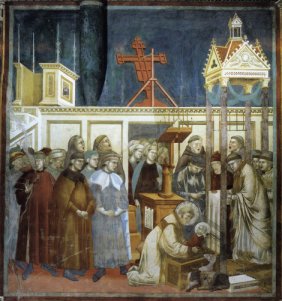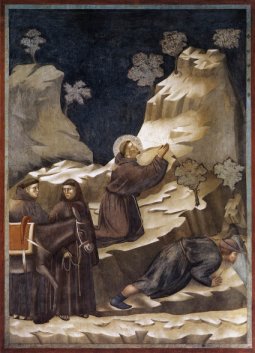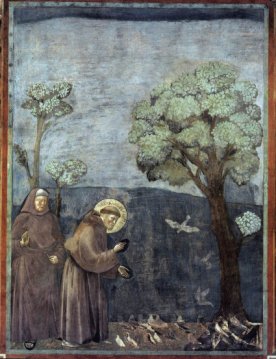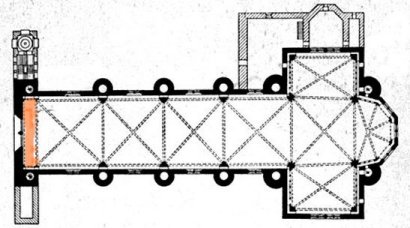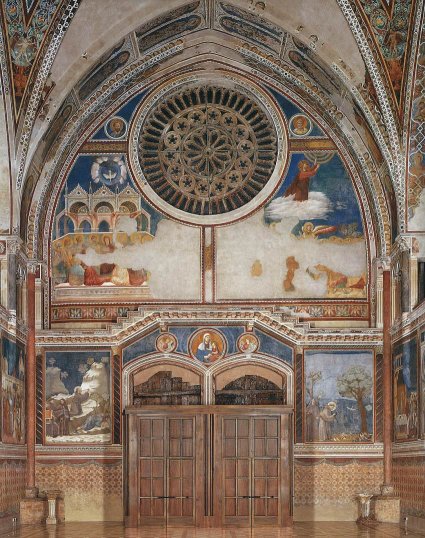|
At the side of the rose window:
Pentecost (left) Ascension of Christ (right). Above the doors: St Peter,
Madonna and Child, St. Paul.
Franciscan scenes, including those adjacent to the East wall: 13.
Nativity scene at Greccio. 14. The miracle of the spring. 15. Preaching
to the birds. 16. The death of the knight of Celano.
Nativity plays are a familiar event in infant schools in the
U.K., though generally they are more secular than devotional events.
According to Bonaventure and others, this recreation at Greccio was the
first. Recreating the nativity is, of course, a powerful symbol of
rebirth. It comes as no surprise to find that the small building which is the
supposed birthplace of St Francis in Assisi, knows as 'San Francesco
Piccolino' is described as having been a stable. As Francis's father was a
well-to-do merchant, this is not entirely convincing, and the legend
probably dates from the fifteenth century.
The two scenes on the East wall itself are central to the story
of Francis, and are not part of the chronological sequence of the other
Franciscan scenes. The miracle of the spring is described by
Bonaventure (VII 12). On a long journey, Francis caused water to gush
from the mountainside for a fellow traveller to drink, a direct
reference to Moses. Francis was the provider of the water of life in
both the real and spiritual sense.
Francis preaching to the birds is perhaps the best known of all
Franciscan images. It raises many questions. As a layman, Francis was
not supposed to preach, but he did so anyway. One suggestion is
that the birds represent the poor that Francis preached too; picturing
him preaching to people would not be acceptable.
Francis is often regarded as a proto-environmentalist, but
there is a little more to the story than that. In The Tree of
Life Bonaventure writes about the Crucifixion as a rebirth for
humanity, and the metaphor for this is the Cross bursting into bloom,
like the tree in the image. Franciscans regarded the life of Francis as
offering a second rebirth.
The death of the knight at Celano is another somewhat equivocal image.
Francis could not preach, nor could he hear deathbed confessions, though
here it is fairly clear that the dying knight is seeking Francis's
intercession. How to get round the problem? the figure sitting at the
table, it is suggested, was originally intended to be a priest (though
he seems more interested in his lunch than in the dying knight.)
Evidence put forward for this is that the garment beneath the table is
more like that of a priest than a friar. The view is that the rest of
the figure has been repainted.
Throughout all of the images there is concern about Francis doing
things he should not be doing. The justification offered is that, while,
Francis was not an ordained priest, neither were the prophets with whom
he is identified; nor, indeed was Christ.
The New Testament images of the Ascension and Pentecost flow on
from the middle register of the south wall. The Ascension image brings
to mind the Death of Francis in bay 2. Pentecost is regarded as
the birth of the church, with the apostles inspired to preach and spread
the gospel. This was Francis's task too. |
